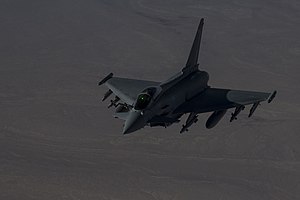Operation Shader
| Operation Shader | |||||||
|---|---|---|---|---|---|---|---|
| Part of the Military intervention against ISIL in Iraq, and Syria and Foreign involvement in the Syrian Civil War |
|||||||
 A Typhoon FGR4 flies over Iraq on 22 December 2015. |
|||||||
|
|||||||
| Belligerents | |||||||
|
|
|
||||||
| Commanders and leaders | |||||||
|
|
|
||||||
| Units involved | |||||||
|
|
|
||||||
| Strength | |||||||
|
|
||||||
| Casualties and losses | |||||||
|
38 civilians in Tunisia 3 Volunteers 1 serviceman killed (accident) |
1000+ killed | ||||||
Ongoing
38 civilians in Tunisia 3 Volunteers
Operation Shader is the operational code name given to the British participation in the ongoing military intervention against the Islamic State of Iraq and the Levant (ISIL). The operation began in Iraq on 26 September 2014, following a formal request for assistance by the Iraqi government. Prior to this, the Royal Air Force had been engaged in a humanitarian relief effort over Mount Sinjar, which involved multiple aid airdrops by transport aircraft and the airlifting of displaced refugees. By 21 October 2014, the intervention had extended onto Syria with the Royal Air Force only mandated to conduct surveillance flights over the country. On 2 December 2015, the House of Commons approved British airstrikes against ISIL in Syria. The UK is one of several countries directly involved in the ongoing Syrian conflict that started in March 2011.
By June 2016, the Ministry of Defence had announced that over 1,000 personnel were engaged in theatre and that the Royal Air Force had conducted around 900 airstrikes, flying over 2,200 sorties, killing almost 1,000 ISIL fighters. In December 2016, it was reported that the Royal Air Force is operating at its most intense for 25 years in a single theatre of operation which far outstripped the UK involvement in Iraq and Afghanistan - RAF jets have dropped 11 times more bombs (1,276 strikes) on Syria and Iraq in the preceding 12 months than they had in the busiest year of action in Afghanistan a decade previously (119).
On 9 August 2014, following the genocidal persecution of minorities in Northern Iraq, the British government deployed the Royal Air Force to conduct humanitarian aid airdrops. The first airdrop was conducted on 9 August, with two Lockheed C-130 Hercules aircraft, flying from RAF Akrotiri, airdropping bundles of aid into Mount Sinjar. A second airdrop commenced on 12 August 2014 but had to be aborted due to a perceived risk of injury to civilians. The airdrops were able to resume within 24 hours and two large consignments of aid were airdropped over Mount Sinjar. During the same day, the Ministry of Defence announced the deployment of Panavia Tornado GR.4 strike aircraft to help coordinate the airdrops using their LITENING III reconnaissance pods; they were not authorized to conduct any airstrikes prior to Parliamentary approval. Four Boeing Chinook transport helicopters were also deployed alongside them to participate in any required refugee rescue missions. On 13 August 2014, two Hercules aircraft dropped a third round of humanitarian aid into Mount Sinjar. This was followed by a fourth and final round on 14 August, bringing the total number of humanitarian aid airdrops conducted by the RAF to seven. The UK suspended its humanitarian aid airdrops on 14 August 2014, citing the improved humanitarian situation in Mount Sinjar.
...
Wikipedia
